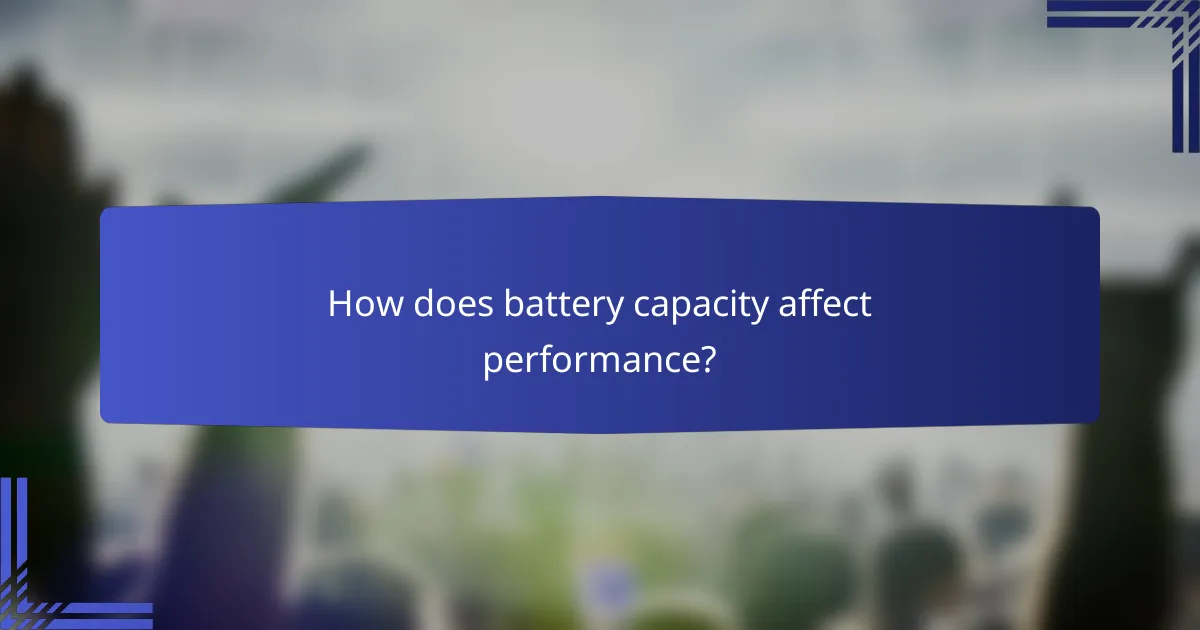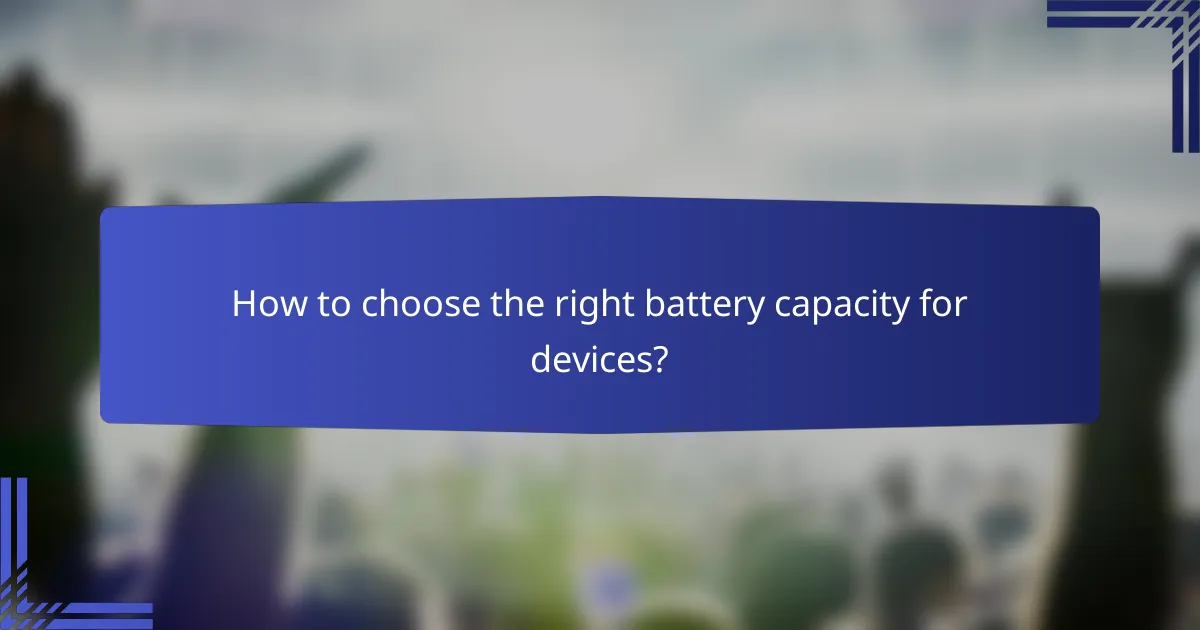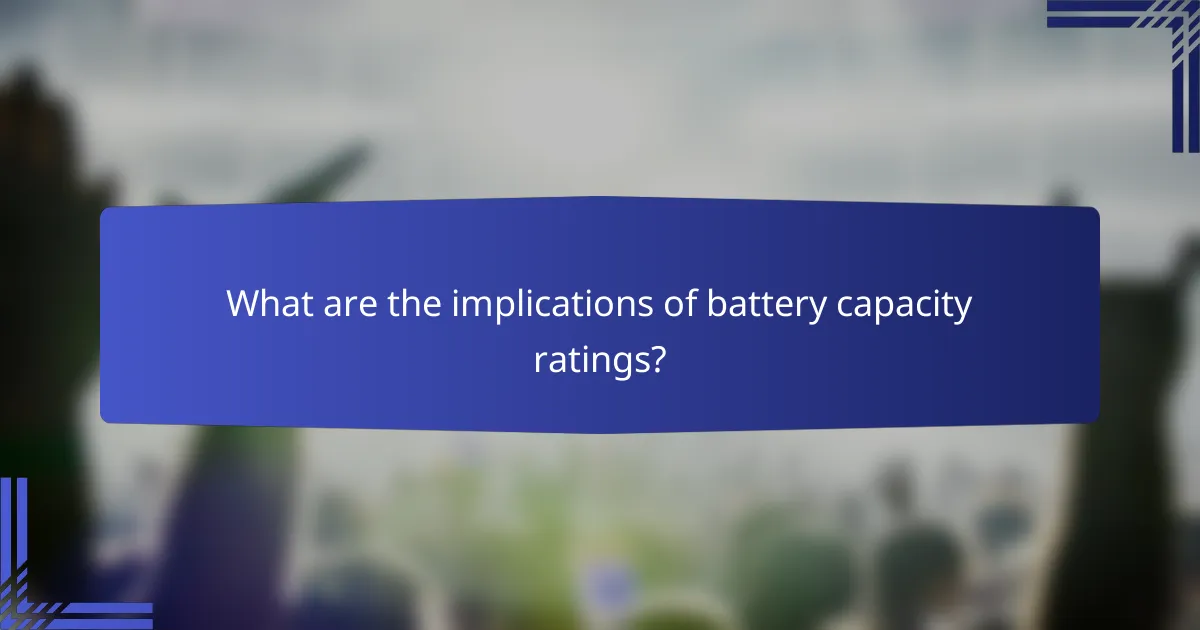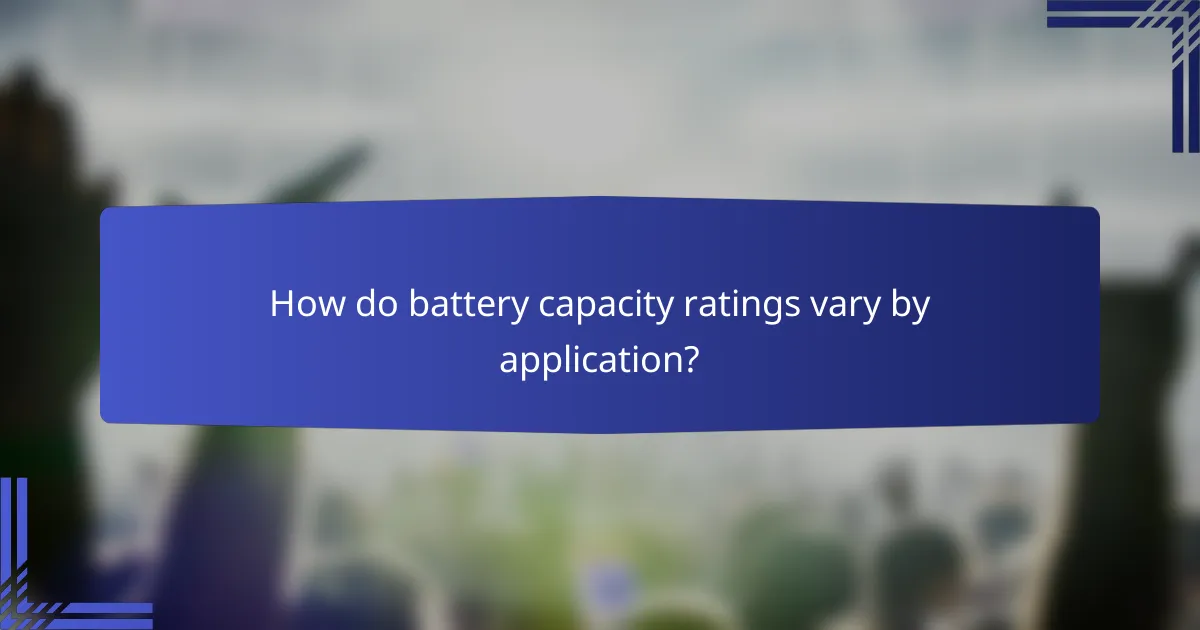Battery capacity ratings are crucial for understanding how long a device can function before requiring a recharge, with higher capacities typically offering extended runtimes. These ratings, measured in ampere-hours (Ah), watt-hours (Wh), and milliampere-hours (mAh), provide essential insights into a battery’s performance and its suitability for various applications. Selecting the appropriate battery capacity requires careful consideration of your device’s energy needs and usage patterns to ensure optimal performance.

How does battery capacity affect performance?
Battery capacity significantly influences performance by determining how long a device can operate before needing a recharge. Higher capacity generally translates to longer runtimes, but it can also affect efficiency and lifespan.
Direct correlation with runtime
The runtime of a device is directly linked to its battery capacity. For instance, a smartphone with a battery rated at 4000 mAh can typically last longer than one with a 3000 mAh battery under similar usage conditions. Users should consider their daily usage patterns to choose a device with adequate capacity for their needs.
In practical terms, devices with higher capacities can support more demanding applications or extended usage without frequent recharging. This is particularly important for users who rely on their devices throughout the day.
Impact on device efficiency
Battery capacity can influence the overall efficiency of a device. A larger battery may allow for lower power draw, as the device can operate at optimal levels without draining quickly. This can lead to improved performance, especially in high-demand scenarios like gaming or video streaming.
However, larger batteries can also add weight and size to devices, which may not be desirable for all users. It’s essential to balance capacity with portability based on individual preferences and usage requirements.
Influence on charging cycles
Batteries with higher capacity often undergo fewer charging cycles, which can enhance their longevity. For example, a device that can run for two days on a single charge will require fewer recharges than one that needs daily charging. This reduction in cycles can help maintain battery health over time.
Users should be mindful of their charging habits; frequent partial charges can be beneficial for lithium-ion batteries, as they prefer not to be fully discharged regularly. Understanding this can help extend the battery’s usable life.
Effect on overall lifespan
The lifespan of a battery is closely tied to its capacity and usage patterns. Generally, batteries with higher capacity can last longer before their performance degrades. However, factors such as temperature, charging habits, and discharge rates also play critical roles in determining lifespan.
To maximize battery lifespan, users should avoid exposing devices to extreme temperatures and try to maintain a charge level between 20% and 80%. This practice can help ensure that the battery remains functional for a longer period, reducing the need for replacements.

What are the different battery capacity ratings?
Battery capacity ratings indicate how much energy a battery can store and deliver. The most common ratings include ampere-hours (Ah), watt-hours (Wh), and milliampere-hours (mAh), each providing unique insights into a battery’s performance and suitability for specific applications.
Ampere-hour (Ah) explained
Ampere-hour (Ah) is a unit that measures the amount of electric charge a battery can deliver over a specific period. For example, a battery rated at 10 Ah can theoretically provide 10 amps for one hour or 1 amp for ten hours. This rating is crucial for applications where sustained power is needed, such as in electric vehicles or backup power systems.
When evaluating batteries, consider the Ah rating in relation to the device’s power consumption. A higher Ah rating typically means longer usage times between charges, but it may also result in a larger and heavier battery, which could be a trade-off in portable devices.
Watt-hour (Wh) significance
Watt-hour (Wh) measures the total energy capacity of a battery, calculated by multiplying the voltage (V) by the ampere-hour (Ah) rating. For instance, a 12V battery with a 10 Ah rating has a capacity of 120 Wh. This metric is particularly useful for understanding how long a battery can power a device given its voltage and current requirements.
When selecting batteries, look at the Wh rating to ensure it meets the energy demands of your devices. For example, a laptop may require a battery with a capacity of at least 50-100 Wh for several hours of operation, depending on usage patterns.
Understanding milliampere-hour (mAh)
Milliampere-hour (mAh) is a smaller unit of measure commonly used for batteries in portable electronics, such as smartphones and tablets. One mAh equals one-thousandth of an ampere-hour, making it suitable for devices with lower power requirements. A battery rated at 3000 mAh can deliver 3000 milliamperes for one hour.
When comparing devices, a higher mAh rating generally indicates longer battery life. However, it’s essential to consider the device’s power consumption; a device that consumes more power will deplete a battery with a high mAh rating faster than a more efficient device. Aim for a balance between mAh and the device’s energy needs for optimal performance.

How to choose the right battery capacity for devices?
Choosing the right battery capacity involves understanding the energy needs of your device and how you plan to use it. Consider factors like device specifications, usage frequency, and compatibility with existing systems to make an informed decision.
Consider device requirements
Each device has specific power needs that dictate the battery capacity required for optimal performance. For example, smartphones typically need batteries ranging from 2,500 to 5,000 mAh, while laptops may require capacities of 40,000 mAh or more. Always check the manufacturer’s specifications to ensure the battery meets the device’s requirements.
Higher capacity batteries can provide longer usage times but may also add weight and size to the device. Balance the need for longevity with the practicality of the device’s design.
Evaluate usage patterns
Your usage patterns significantly influence the battery capacity you should choose. If you frequently use power-intensive applications like gaming or video streaming, opt for a battery with a higher capacity to avoid frequent recharging. For light users, a standard capacity may suffice.
Consider how often you charge your device. If you’re often near a power source, a smaller capacity may be adequate. However, for users on the go, a larger capacity battery can provide peace of mind and convenience.
Assess compatibility with existing systems
Ensure that the battery you select is compatible with your device’s existing systems. This includes checking the voltage and connector type, as mismatches can lead to performance issues or even damage. Many devices have proprietary batteries, so using the recommended model is crucial.
When upgrading or replacing batteries, consider whether your device can handle higher capacity options. Some devices may have limitations that prevent them from utilizing batteries with significantly greater capacities, which could lead to inefficiencies.

What are the implications of battery capacity ratings?
Battery capacity ratings indicate how much energy a battery can store, directly affecting its performance, longevity, and suitability for specific applications. Understanding these ratings is crucial for consumers and manufacturers alike, as they influence everything from device efficiency to regulatory compliance.
Effects on performance metrics
Battery capacity ratings significantly impact performance metrics such as runtime, charge time, and efficiency. A higher capacity typically means longer usage times between charges, but it may also lead to longer charging periods. For instance, a battery rated at 3000 mAh may last longer in a smartphone compared to one rated at 2000 mAh, assuming similar power consumption.
Additionally, the discharge rate is influenced by capacity; batteries with higher ratings can often sustain higher loads without significant voltage drops. This is particularly important in applications like electric vehicles, where consistent performance is critical for safety and user experience.
Regulatory compliance considerations
Battery capacity ratings must align with various regulatory standards to ensure safety and environmental compliance. In the European Union, for example, batteries must meet the Battery Directive, which includes requirements for capacity labeling and recycling. Non-compliance can lead to penalties and restrictions in the market.
Manufacturers should also be aware of local regulations regarding battery disposal and recycling, as these can vary significantly by region. Understanding these requirements helps in designing products that not only meet performance expectations but also adhere to legal standards.
Impact on warranty and support
Battery capacity ratings can influence warranty terms and support options offered by manufacturers. A battery with a higher capacity may come with a longer warranty period, reflecting greater confidence in its durability and performance. Conversely, lower-capacity batteries might have shorter warranties due to their limited lifespan.
Consumers should review warranty details carefully, as some manufacturers may specify conditions related to battery capacity performance. For example, if a battery degrades below a certain capacity threshold within the warranty period, it may be eligible for replacement, ensuring users receive adequate support.

How do battery capacity ratings vary by application?
Battery capacity ratings differ significantly across applications, reflecting the unique energy demands of each device. Understanding these variations helps consumers choose the right battery for their needs, ensuring optimal performance and longevity.
Smartphones vs. laptops
Smartphones typically have battery capacities ranging from about 2,000 to 5,000 mAh, designed for daily tasks like calling, texting, and browsing. In contrast, laptops generally feature larger batteries, often between 40 to 100 watt-hours (Wh), to support more intensive activities such as gaming and productivity applications.
When selecting a device, consider how battery life aligns with your usage patterns. For instance, a smartphone may last a full day on a single charge, while a laptop may require more frequent charging depending on its workload and power settings.
Electric vehicles specifications
Electric vehicles (EVs) have battery capacities measured in kilowatt-hours (kWh), typically ranging from around 30 kWh for smaller models to over 100 kWh for high-performance vehicles. This capacity directly impacts the vehicle’s range, with many EVs offering between 150 to 370 miles on a full charge.
When evaluating an EV, consider both the battery capacity and the efficiency of the vehicle. A higher capacity battery may provide longer range, but factors like driving habits and terrain can significantly influence actual performance.
Portable electronics differences
Portable electronics, such as tablets and cameras, usually have battery capacities that fall between smartphones and laptops, often ranging from 3,000 to 10,000 mAh. These devices are designed for specific tasks, so their battery life can vary widely based on usage, with tablets typically lasting longer than smartphones due to larger batteries.
When choosing portable electronics, assess how battery capacity meets your needs. For example, a tablet with a 10,000 mAh battery may provide several hours of video playback, making it suitable for travel, while a camera with a smaller battery may require more frequent recharging during extended use.
